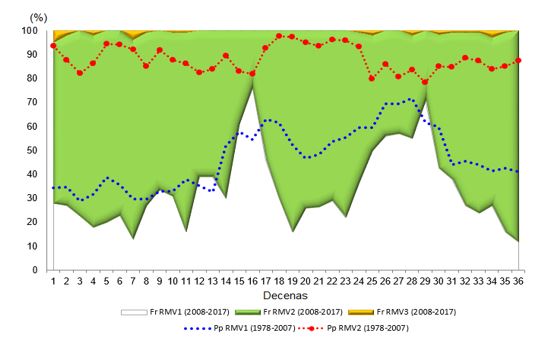Predominant probabilities of occurrence of wind speed in the north coast of eastern Cuba
Main Article Content
Abstract
Synoptic climatology studies the relationship between atmospheric circulation and the surface environment. To determine the predominant probabilities of occurrence of the average wind speed in selected stations of the north coast in the eastern half of Cuba, according to the types of influential synoptic situations, a methodological design of subseasonal synoptic-statistical forecast is elaborated, which uses the databases of the classifications of the types of synoptic situations and the average wind speed records during the period between 1978 and 2017. A logical process diagram represents the sequence in which the steps that make up the methodology used to calculate the predominant probabilities of occurrence of the classes of average wind speed, through the concept of conditional probability, which previously establishes the existence of statistical association between the categorical variables: types of synoptic situations and average wind speed, through a Chi-test Pearson square. The verification of the synoptic-statistical forecast shows good accuracy towards the extreme east of Cuba (Punta de Maisí) and acceptable in the central east (Nuevitas), except in the summer period. The greatest coherence between the different statistical error measures determined was obtained for the average wind speed class of 3.5 to 9.4 m/s, which is the one with the greatest predictive interest since it has High wind potential. The result obtained provides new knowledge about atmospheric circulation and its relationship with the average speed of the wind on the surface, and due to its predictive usefulness, it will contribute to greater efficiency in the planning, execution of maintenance and management of existing wind installations. and projected.
Downloads
Article Details

This work is licensed under a Creative Commons Attribution-NonCommercial 4.0 International License.
Those authors who have publications with this journal accept the following terms of the License Attribution-NonCommercial 4.0 International (CC BY-NC 4.0):
You are free to:
- Share — copy and redistribute the material in any medium or format
- Adapt — remix, transform, and build upon the material
The licensor cannot revoke these freedoms as long as you follow the license terms.
Under the following terms:
- Attribution — You must give appropriate credit, provide a link to the license, and indicate if changes were made. You may do so in any reasonable manner, but not in any way that suggests the licensor endorses you or your use.
- NonCommercial — You may not use the material for commercial purposes.
- No additional restrictions — You may not apply legal terms or technological measures that legally restrict others from doing anything the license permits.
The journal is not responsible for the opinions and concepts expressed in the works, they are the sole responsibility of the authors. The Editor, with the assistance of the Editorial Committee, reserves the right to suggest or request advisable or necessary modifications. They are accepted to publish original scientific papers, research results of interest that have not been published or sent to another journal for the same purpose.
The mention of trademarks of equipment, instruments or specific materials is for identification purposes, and there is no promotional commitment in relation to them, neither by the authors nor by the publisher.
References
Boytel, F. (1972). Geografía Eólica de Oriente. La Habana: Ed. Ciencia y Técnica, 251 pp.
Hoel, P. (1972). Introducción a la Estadística Matemática. Edición Revolucionaria, 471 pp.
Lapinel, B. (1988). La circulación atmosférica y las características espacio-temporales de las lluvias en Cuba. [Tesis de Doctorado]. Instituto de Meteorología, 147 pp.
Lecha, L., Sánchez, L., Verdecia, Y., Soler, E. y Sánchez, A. (2020). “Variabilidad de los tipos de situaciones sinópticas influyentes sobre el occidente de Cuba”. Revista Cubana de Meteorología, Vol. 26, No 2, 1-18 pp., ISSN: 2664-0880. http://rcm.insmet.cu/ index.php/rcm/article/view/507
León, G. (2005). Verificación de los modelos meteorológicos. Nota Técnica IDEAM/METEO 0001/05, Instituto de Hidrología, Meteorología y Estudios Ambientales, 41 pp.
Roque, A., Montenegro, U. y Peña A. (2018). Particularidades del viento en la región oriental del país. Revista Cubana de Meteorología, Vol. 24, No 3, 335-348 pp., ISSN: 2664-0880.
Sánchez, H. H., Reyes, C. y Mejía, K. (2018). Manual de términos en investigación científica, tecnológica y humanística. Edit. Universidad Ricardo Palma, 146 pp., ISBN Nº 978-612-47351-4-1. https://www.urp.edu.pe/pdf/id/13350/n/libro-manual-de-terminos-en-investigacion.pdf
Soler, E., Lecha, L. B., Sánchez, L. M. y Verdecia, Y. (2020). Catálogo de los Tipos de Situaciones Sinópticas que influyen sobre Cuba. Informe Científico Técnico, Instituto de Meteorología, 59 pp.
Soler, E., Sánchez, L. M., Lecha, L. B. y Verdecia, Y. (2021). “Los tipos de situaciones sinópticas que influyen sobre la mitad occidental de Cuba y su relación con la rapidez media del viento en La Fe, Isla de la Juventud”. Revista Cubana de Meteorología, Vol. 27, No 3, 14 pp. ISSN: 2664-0880.
Soler, E., Sánchez, L. M., Rojas, N. y Cardoso, A. (2022). Elaboración de la base metodológica para el pronóstico sinóptico-estadístico subestacional de la rapidez media del viento en estaciones meteorológicas seleccionadas de Cuba. Informe de Resultado, Instituto de Meteorología, 39 pp.
Soltura, R., Roque, A., Rivero, I., Wallo, A., Báez, R., Vázquez, R., Rivero, R., Ayala, L., Rodríguez, G., Carrasco, H., Curbelo, A., González, A., Herrera, O., Martín G. y Díaz, J. C. (2009). “Primera edición del Mapa de Potencial Eólico de Cuba”. Revista Eco Solar, 21(06), 1-18, http://www.cubasolar.cu/biblioteca/Ecosolar/Ecosolar21/HTML/articulo06.htm
Souza, M.S., Giordano, C. J. y Migliorati M. A. (2012). Hacia la tesis: itinerarios conceptuales y metodológicos para la investigación en comunicación. Universidad Nacional de La Plata, 160 pp.
Villareal, F. (2016). Introducción a los Modelos de Pronósticos. Universidad Nacional del Sur, 121 pp.
Yarnal, B. (1993). Synoptic Climatology in Environmental Analysis. Belhaven Press, 200 pp.

